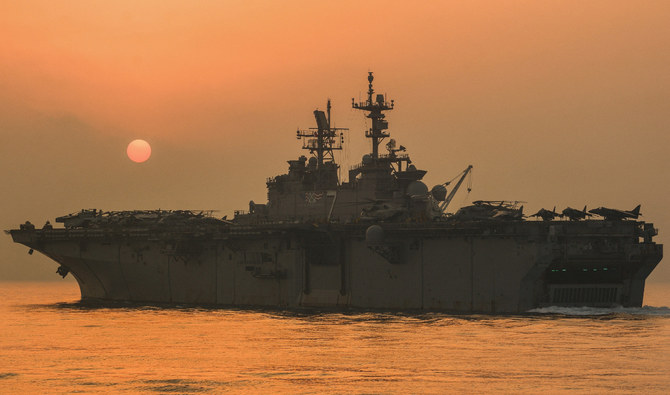The US Navy’s Mideast-based 5th Fleet said on Wednesday it will launch a new task force that incorporates airborne, sailing and underwater drones after years of maritime attacks linked to ongoing tensions with Iran.
Navy officials refused to identify which systems they would introduce from Bahrain. However, they promised the coming months would see the drones stretch their capabilities across a region of chokepoints crucial to both global energy supplies and worldwide shipping.
“We want to put more systems out in the maritime domain above, on and below the sea,” said Vice Adm. Brad Cooper, who leads the 5th Fleet. “We want more eyes on what’s happening out there.”
The 5th Fleet includes the crucial Strait of Hormuz, the narrow mouth of the Arabian Gulf through which 20 percent of all oil passes. It also stretches as far as the Red Sea reaches near the Suez Canal, the waterway in Egypt linking the Mideast to the Mediterranean, and the Bab Al-Mandab Strait off Yemen.
The systems being used by the 5th Fleet’s new Task Force 59 will include some of those involved in an April test led by the Navy’s Pacific Fleet. Drones used in that exercise included ultra-endurance aerial surveillance drones, surface ships the Sea Hawk and the Sea Hunter and smaller underwater drones that resemble torpedoes.
The 5th Fleet includes shallow water areas, salty waters and temperatures in the summertime that can go above 45 degrees Celsius with high humidity. That can prove rough for crewed vessels, let alone those running remotely.
“I think that environment really suits us well to experiment and move faster,” Cooper said. “And our belief is if the new systems can work here, they can probably work anywhere else and can scale them across other fleets.”
Separately, the UN atomic watchdog said Iran has continued to increase its stockpile of highly enriched uranium that could be used to make nuclear weapons in contravention of a 2015 accord with world powers that was meant to contain Tehran’s nuclear program.
The International Atomic Energy Agency also told member states in its confidential quarterly report that its verification and monitoring activities have been “seriously undermined” since February by Iran’s refusal to let inspectors access IAEA monitoring equipment.
The Vienna-based agency told members that its confidence in properly assessing Iran’s activities — what it called the “continuity of knowledge” — was declining over time and that would continue “unless the situation is immediately rectified by Iran.”
The IAEA said certain monitoring and surveillance equipment cannot be left for more than three months without being serviced. It was provided with access this month to four surveillance cameras installed at one site, but one of the cameras had been destroyed and a second had been severely damaged, the agency said.
Its director-general, Rafael Mariano Grossi, said he was willing to travel to Iran to meet the recently elected government for talks on the issue.
The agency said it estimates Iran’s stock of uranium enriched to up to 60 percent fissile purity at 10 kg, an increase of 7.6 kg since May, while the country’s stockpile of uranium enriched to up to 20 percent fissile purity is now estimated at 84.3 kg, up from 62.8 kg three months earlier.
Iran’s total stock of uranium is estimated at 2,441.3 kg as of Aug. 30, down from 3,241 kg on May 22, the agency said.

